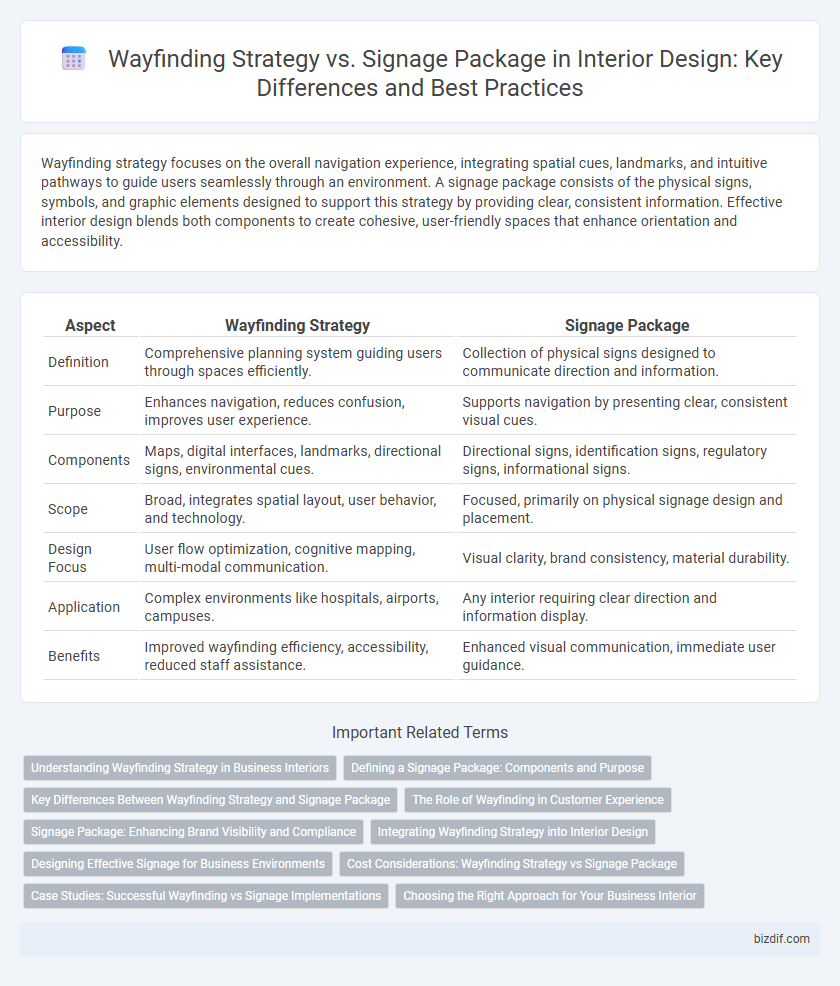Wayfinding strategy focuses on the overall navigation experience, integrating spatial cues, landmarks, and intuitive pathways to guide users seamlessly through an environment. A signage package consists of the physical signs, symbols, and graphic elements designed to support this strategy by providing clear, consistent information. Effective interior design blends both components to create cohesive, user-friendly spaces that enhance orientation and accessibility.
Table of Comparison
| Aspect | Wayfinding Strategy | Signage Package |
|---|---|---|
| Definition | Comprehensive planning system guiding users through spaces efficiently. | Collection of physical signs designed to communicate direction and information. |
| Purpose | Enhances navigation, reduces confusion, improves user experience. | Supports navigation by presenting clear, consistent visual cues. |
| Components | Maps, digital interfaces, landmarks, directional signs, environmental cues. | Directional signs, identification signs, regulatory signs, informational signs. |
| Scope | Broad, integrates spatial layout, user behavior, and technology. | Focused, primarily on physical signage design and placement. |
| Design Focus | User flow optimization, cognitive mapping, multi-modal communication. | Visual clarity, brand consistency, material durability. |
| Application | Complex environments like hospitals, airports, campuses. | Any interior requiring clear direction and information display. |
| Benefits | Improved wayfinding efficiency, accessibility, reduced staff assistance. | Enhanced visual communication, immediate user guidance. |
Understanding Wayfinding Strategy in Business Interiors
Wayfinding strategy in business interiors involves designing intuitive navigation systems that enhance user experience by minimizing confusion and improving flow. It integrates spatial layout, visual cues, and behavioral patterns to guide occupants naturally through complex environments. Unlike a signage package, which focuses primarily on physical signs, wayfinding strategy encompasses a holistic approach including architectural elements, digital tools, and user psychology to optimize internal movement and brand perception.
Defining a Signage Package: Components and Purpose
A signage package in interior design encompasses a comprehensive set of visual communication tools, including directional signs, identification plaques, informational displays, and regulatory signs, all tailored to enhance user navigation and brand consistency. Its primary purpose is to provide clear, cohesive wayfinding elements that guide occupants seamlessly through a space while reinforcing the architectural and aesthetic themes. Effective signage packages integrate materials, typography, color schemes, and message hierarchy to optimize legibility, accessibility, and overall spatial experience.
Key Differences Between Wayfinding Strategy and Signage Package
Wayfinding strategy encompasses the comprehensive planning and design of user navigation within a space, addressing spatial orientation, visual cues, and user experience. Signage package refers specifically to the selection, design, and implementation of physical signs that communicate directions, information, and branding. Key differences lie in wayfinding strategy's broader focus on behavioral patterns and environmental psychology, while signage package delivers tangible elements like directional signs, identification plaques, and informational boards.
The Role of Wayfinding in Customer Experience
Wayfinding strategy is a comprehensive plan that guides customers through physical spaces using visual cues, spatial layout, and environmental design to enhance navigational ease. A signage package, while essential, serves as a component within this broader strategy, providing clear, consistent, and strategically placed signs that support intuitive movement. Effective wayfinding improves customer experience by reducing confusion, increasing accessibility, and promoting a seamless journey through the environment.
Signage Package: Enhancing Brand Visibility and Compliance
Signage packages play a crucial role in interior design by enhancing brand visibility through cohesive and strategically designed visual elements that align with a company's identity. They ensure compliance with regulatory standards such as ADA guidelines, improving accessibility and safety within the space. Effective signage packages combine aesthetic appeal with functional clarity, guiding occupants seamlessly while reinforcing brand presence.
Integrating Wayfinding Strategy into Interior Design
Integrating wayfinding strategy into interior design enhances spatial navigation by embedding intuitive visual cues and architectural elements that guide users seamlessly. A comprehensive signage package complements this by providing consistent, strategically placed markers that reinforce the directional flow within the environment. Together, they create a cohesive user experience that improves accessibility, reduces confusion, and supports the overall aesthetic harmony of the space.
Designing Effective Signage for Business Environments
Designing effective signage for business environments requires a strategic wayfinding approach that integrates directional cues with brand identity. A comprehensive wayfinding strategy ensures intuitive navigation through spatial planning, while a well-crafted signage package employs visual hierarchy, color contrast, and typography for clear communication. Combining these elements enhances user experience, promotes safety, and reinforces the business's professional image.
Cost Considerations: Wayfinding Strategy vs Signage Package
Wayfinding strategy development often requires a higher initial investment due to in-depth spatial analysis, user behavior research, and design integration, ensuring long-term navigational efficiency. In contrast, signage packages typically have lower upfront costs but might incur additional expenses over time for updates and maintenance as they address immediate directional needs without broader strategic planning. Budget allocation should consider the balance between comprehensive wayfinding outcomes and the practicality of signage implementation within the project scope.
Case Studies: Successful Wayfinding vs Signage Implementations
Case studies reveal that wayfinding strategies focusing on spatial cognition outperform traditional signage packages by improving user navigation and reducing confusion in complex environments. Successful implementations integrate intuitive landmarks, clear visual cues, and logical route mapping rather than relying solely on text-heavy signs. This approach enhances user experience in hospitals, airports, and large commercial spaces, demonstrating measurable increases in efficiency and satisfaction.
Choosing the Right Approach for Your Business Interior
Selecting the ideal wayfinding strategy involves analyzing spatial complexity, user behavior, and brand identity to guide visitors intuitively through your business interior. In contrast, a signage package emphasizes the design and consistency of visual elements, such as directional signs, informational plaques, and branding displays, to reinforce navigation. Prioritizing a tailored combination of both ensures functional clarity and aesthetic coherence, enhancing overall user experience within the space.
Wayfinding Strategy vs Signage Package Infographic

 bizdif.com
bizdif.com